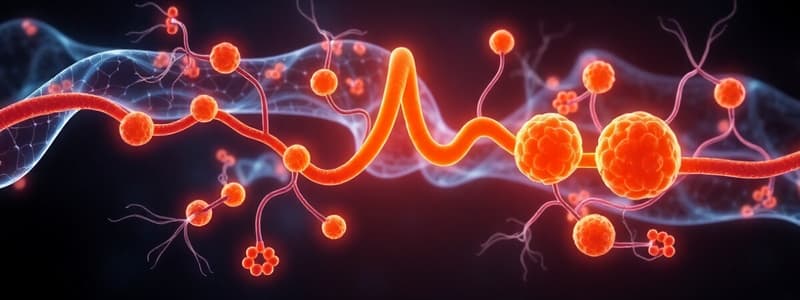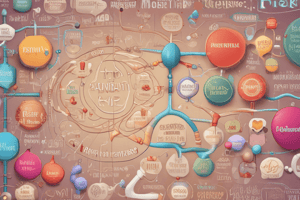Podcast
Questions and Answers
What occurs when lactose is not digested in the intestine?
What occurs when lactose is not digested in the intestine?
- Lactose is absorbed into the bloodstream.
- Lactose does not affect the digestive process.
- Intestinal bacteria ferment lactose producing acids and gases. (correct)
- Lactose is converted into glucose by intestinal cells.
Which of the following represents a catabolic pathway?
Which of the following represents a catabolic pathway?
- Gluconeogenesis
- Glycogenesis
- Citric acid cycle
- Glycolysis (correct)
During which stage of glycolysis is energy consumed?
During which stage of glycolysis is energy consumed?
- Only the energy-releasing stage.
- Only the energy-requiring stage. (correct)
- Both stages consume energy.
- Glycolysis does not consume energy.
What is produced by anaerobic glycolysis?
What is produced by anaerobic glycolysis?
Which tissue would primarily rely on glycolysis due to a lack of mitochondria?
Which tissue would primarily rely on glycolysis due to a lack of mitochondria?
Which intermediate from glycolysis plays a role in lipogenesis?
Which intermediate from glycolysis plays a role in lipogenesis?
What effect does 2,3-bisphosphoglycerate have in the body?
What effect does 2,3-bisphosphoglycerate have in the body?
What is the primary outcome of glycolysis under aerobic conditions?
What is the primary outcome of glycolysis under aerobic conditions?
What is the net energy gain from aerobic glycolysis?
What is the net energy gain from aerobic glycolysis?
Which enzyme's synthesis is stimulated by insulin during glycolysis?
Which enzyme's synthesis is stimulated by insulin during glycolysis?
What happens to NADH + H+ in anaerobic glycolysis?
What happens to NADH + H+ in anaerobic glycolysis?
Which of the following inhibits phosphofructokinase-1?
Which of the following inhibits phosphofructokinase-1?
What is the role of fructose 2,6 biphosphate in glycolysis?
What is the role of fructose 2,6 biphosphate in glycolysis?
What is the main product of glycolysis in mature red blood cells?
What is the main product of glycolysis in mature red blood cells?
How does ATP affect the activity of phosphofructokinase-1?
How does ATP affect the activity of phosphofructokinase-1?
What is substrate level phosphorylation?
What is substrate level phosphorylation?
What describes the function of anabolic pathways?
What describes the function of anabolic pathways?
Which of the following is a product of catabolic pathways?
Which of the following is a product of catabolic pathways?
Which enzyme is responsible for converting starch into dextrins?
Which enzyme is responsible for converting starch into dextrins?
What is the role of intestinal disaccharidases in carbohydrate metabolism?
What is the role of intestinal disaccharidases in carbohydrate metabolism?
Lactose intolerance is primarily caused by a deficiency in which enzyme?
Lactose intolerance is primarily caused by a deficiency in which enzyme?
What is the primary function of amphibolic pathways?
What is the primary function of amphibolic pathways?
What percentage of daily calories does carbohydrate provide in the body?
What percentage of daily calories does carbohydrate provide in the body?
Which of the following carbohydrates is primarily derived from fruits and honey?
Which of the following carbohydrates is primarily derived from fruits and honey?
Flashcards
Metabolism
Metabolism
The chemical reactions in the body that break down or build up substances.
Anabolic pathways
Anabolic pathways
Build complex molecules from simpler ones, requiring energy.
Catabolic pathways
Catabolic pathways
Break down complex molecules into simpler ones, releasing energy.
Amphibolic pathways
Amphibolic pathways
Signup and view all the flashcards
Carbohydrate Metabolism
Carbohydrate Metabolism
Signup and view all the flashcards
Digestion of CHO
Digestion of CHO
Signup and view all the flashcards
Salivary amylase
Salivary amylase
Signup and view all the flashcards
Pancreatic amylase
Pancreatic amylase
Signup and view all the flashcards
Intestinal disaccharidases
Intestinal disaccharidases
Signup and view all the flashcards
Lactose intolerance
Lactose intolerance
Signup and view all the flashcards
Lactose Intolerance
Lactose Intolerance
Signup and view all the flashcards
Lactose Digestion Failure
Lactose Digestion Failure
Signup and view all the flashcards
Glycolysis
Glycolysis
Signup and view all the flashcards
Anaerobic Glycolysis
Anaerobic Glycolysis
Signup and view all the flashcards
Aerobic Glycolysis
Aerobic Glycolysis
Signup and view all the flashcards
Glycolysis Location
Glycolysis Location
Signup and view all the flashcards
Glycolysis Stages
Glycolysis Stages
Signup and view all the flashcards
Glycolysis Importance 1
Glycolysis Importance 1
Signup and view all the flashcards
Glycolysis Importance 2
Glycolysis Importance 2
Signup and view all the flashcards
Glycolysis Importance 3
Glycolysis Importance 3
Signup and view all the flashcards
Glycolysis Importance 4
Glycolysis Importance 4
Signup and view all the flashcards
Substrate-level phosphorylation
Substrate-level phosphorylation
Signup and view all the flashcards
Aerobic glycolysis ATP gain
Aerobic glycolysis ATP gain
Signup and view all the flashcards
Anaerobic glycolysis ATP gain
Anaerobic glycolysis ATP gain
Signup and view all the flashcards
RBC energy production
RBC energy production
Signup and view all the flashcards
RBC glucose uptake
RBC glucose uptake
Signup and view all the flashcards
2,3-BPG production
2,3-BPG production
Signup and view all the flashcards
Key glycolysis enzymes
Key glycolysis enzymes
Signup and view all the flashcards
Hormonal regulation of glycolysis
Hormonal regulation of glycolysis
Signup and view all the flashcards
Allosteric regulation of PFK-1
Allosteric regulation of PFK-1
Signup and view all the flashcards
PFK-2
PFK-2
Signup and view all the flashcards
Fructose-2,6-bisphosphate
Fructose-2,6-bisphosphate
Signup and view all the flashcards
Pyruvate kinase regulation
Pyruvate kinase regulation
Signup and view all the flashcards
Study Notes
CHO Metabolism
- CHO metabolism encompasses the fate of food molecules after digestion and absorption.
- It involves chemical enzymatic reactions within the body focused on building (synthesis) and breaking down (breakdown) various substances.
Metabolic Pathways
- Anabolic pathways: These build complex molecules from simpler ones. This process requires energy (endergonic). Protein synthesis is an example.
- Catabolic pathways: These break complex molecules into simpler ones. This process releases energy (exergonic). Oxidative processes are examples.
- Amphibolic pathways: These act as links between anabolic and catabolic pathways, serving as common metabolic routes. The citric acid cycle is an example.
Carbohydrate Metabolism
- Carbohydrates provide 50% of daily calories.
- Complete oxidation of 1 gram of carbohydrates yields 4 kcal.
- Key carbohydrate sources in food include starch (around 50% of dietary carbohydrates, e.g., potatoes), sucrose and lactose, and fructose and glucose (from fruits and honey).
Digestion of CHO
- Polysaccharides and disaccharides must be broken down into monosaccharides for absorption.
- Enzymes involved in CHO digestion include:
- Salivary amylase (converts starch and glycogen into dextrins)
- Pancreatic amylase (converts dextrins into maltose)
- Intestinal disaccharidases (e.g., maltase, sucrase, lactase) further break down disaccharides into monosaccharides (glucose, fructose, galactose).
Lactose Intolerance
- Definition: A condition where the body lacks the lactase enzyme.
- Cause: Deficiency of Intestinal lactase.
- Effects: Undigested lactose accumulates in the intestine, leading to fermentation by intestinal bacteria and producing acids and gases.
- Symptoms: Abdominal distension, abdominal cramps, and diarrhea.
- Treatment: Lactose-free milk formula.
Metabolic Pathways of Carbohydrates
- Catabolic pathways: These include oxidative pathways like glycolysis, the hexose monophosphate shunt, uronic acid pathway, and glycogenolysis.
- Anabolic pathways: These include gluconeogenesis and glycogenesis.
- Amphibolic pathways: The only amphibolic pathway discussed is the citric acid cycle.
Glycolysis
- Definition: The oxidation of glucose to pyruvate in the presence of oxygen or to lactate in the absence of oxygen.
- Site: Occurs in the cytoplasm of all tissue cells, but particularly important in tissues lacking mitochondria (e.g., red blood cells, cornea, lens) or experiencing frequent oxygen deprivation (e.g., skeletal muscles during exercise).
- Stages:
- Stage 1 (energy requiring): Glucose is converted to 2 molecules of glyceraldehyde-3-phosphate, requiring energy input.
- Stage 2 (energy producing): The 2 glyceraldehyde-3-phosphate molecules are converted to pyruvate (or lactate) producing energy.
Importance of Glycolysis
- Energy production: Anaerobic glycolysis yields 2 ATP, while aerobic glycolysis gives 6-8 ATP.
- Provides a major pathway for the metabolism of fructose and galactose.
- Crucial for good oxygenation of tissues through the formation of 2,3-BPG, altering hemoglobin's oxygen affinity.
- Provides intermediates for other metabolic pathways (e.g., dihydroxyacetone phosphate for lipogenesis, pyruvate for alanine synthesis).
Energy Production in Glycolysis
- Aerobic: Generating 8-10 ATP through substrate-level phosphorylation and oxidative phosphorylation.
- Anaerobic: Generating 2 ATP through substrate-level phosphorylation.
Glycolysis in RBCs
- Mature red blood cells (RBCs) lack mitochondria, so they rely solely on glycolysis for energy.
- The end product is lactate, and net energy produced is 2 ATP.
- Uptake of glucose by RBCs doesn't rely on insulin.
- RBCs produce 2,3-biphosphoglycerate (2,3-BPG).
Regulation of Glycolysis
- Key enzymes (irreversible) are: hexokinase/glucokinase, phosphofructokinase-1 (PFK-1), and pyruvate kinase.
- Hormonal regulation: Insulin stimulates the synthesis of these enzymes, while glucagon inhibits it.
- Allosteric regulation: Different metabolites regulate the activity of these enzymes influencing glycolytic activity.
In Vitro Inhibition of Glycolysis
- Inhibitors: Arsenate (competes with inorganic phosphate), Iodoacetate (inhibits glyceraldehyde-3-phosphate dehydrogenase), and Fluoride (inhibits enolase).
- Clinical significance: Hemolytic anemia (RBCs lysis) can stem from defects in glycolytic enzymes like pyruvate kinase.
Additional Notes
- Glycolysis is a fundamental metabolic pathway, crucial for energy production in various tissues and crucial to overall body function
- Substrate-level phosphorylation is also important
- Regulation mechanisms ensure that glycolysis adjusts to the body's metabolic needs.
- These notes provide a general overview of CHO metabolism and glycolysis. It is essential to refer to more detailed texts for a comprehensive understanding.
Studying That Suits You
Use AI to generate personalized quizzes and flashcards to suit your learning preferences.





